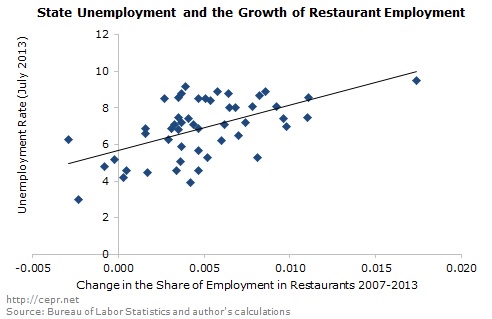Fact-based, data-driven research and analysis to advance democratic debate on vital issues shaping people’s lives.
Center for Economic and Policy Research
1611 Connecticut Ave. NW
Suite 400
Washington, DC 20009
Tel: 202-293-5380
Fax: 202-588-1356
https://cepr.net
September 6, 2013 (Jobs Byte)
By Dean Baker
Bad jobs are increasing because in a weak labor market, workers can’t find anything better.
The Labor Department reported the economy added 169,000 jobs in August, largely in line with expectations. The unemployment rate also edged down to 7.3 percent, the lowest level since December of 2008. However the larger picture in both surveys was not as bright. Downward revisions of 74,000 to the prior two months’ data in the establishment survey bring the rate of job growth over the last three months to just 135,000. This is well below the average of 184,000 a month over the last year.
The small drop in the unemployment rate was due to people leaving the labor force as employment in the household survey fell by 115,000. The employment-to-population ratio edged down to 58.6 percent, just 0.4 percentage points above the low for the downturn.
Government employment showed a rare gain of 17,000 driven by a jump in employment in local education of 20,100. This is likely a seasonal adjustment issue also, as there was a similar jump last year that was reversed in October. Employment in local education is down by more than 200,000 from its peak in 2008. One big job loser this month was the motion picture industry, which lost 22,200 jobs, 5.7 percent of total employment.
Job growth continued to be narrowly concentrated with retail adding 44,000 jobs, health care 32,700 and restaurants 21,200. The jump in health care employment follows three months in which growth averaged just 13,600, so growth is not likely to continue at this pace. Manufacturing added 14,000 jobs driven by a rise of 18,800 jobs in autos. This increase is mostly a seasonal-adjustment issue since the auto sector reported a loss of 10,400 last month. However jobs in the sector are up by 24,300 over the last year.
The sharp rise in retail employment and restaurant work continues the pattern where low-paying sectors show the most rapid growth. While some have argued that this is due to technological changes, the data suggest that a weak labor market is forcing people to take bad jobs. This is seen by the correlation between state unemployment rates and the growth in the share of restaurant jobs. Also, wage growth has been less rapid in the restaurant sector than elsewhere (0.6 percent over the last year in restaurants compared with 1.9 percent overall), the opposite of what would be expected if technology was behind a relative increase in demand for restaurant workers.
Click for a more detailed version of the graph.
The August data showed a reversal of a July decline in the length of the average workweek and overtime hours. There was also a modest uptick in nominal wage growth to a 2.4 percent annual rate over the last three months compared with 2.2 percent over the year.
The household data included several negative items. The duration measures of unemployment all showed increases in August. The percentage of the unemployed who voluntarily quit their jobs fell sharply from 8.6 percent to 7.9 percent. And the number of people counted as discouraged workers was above its year-ago level for the third consecutive month.
On the positive side, the U-6 measure of labor market slack fell from 14.0 percent to 13.7 percent, the lowest since December of 2008. This was driven largely by a sharp decline in the number of people who report working part-time involuntarily. This number fell by 334,000 to 7,911,000. With the number of people involuntarily working part-time running consistently below year-ago levels, the data do not support the stories of employers cutting back hours to avoid the sanctions in the ACA.
Older workers continue to get a disproportionate share of job gains, with employment for people over age 55 rising by 169,000 in August. Over the last year, they have accounted for 57.0 percent of employment growth in the household survey. There is also a reopening of the gap in unemployment rates between men and women, with unemployment for adult men now standing at 7.1 percent compared with 6.3 percent for women.
The overall picture in this report is more of the same. The economy is likely to continue with a moderate pace of job growth that is bit more rapid than the 100,000 jobs needed to keep pace with the growth of the labor force.
